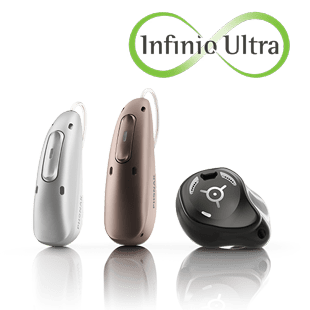
Accessibility strategies for a more inclusive workplace
An early-career audiologist and bimodal user shares how technology, advocacy, and workplace adjustments can improve accessibility for professionals with hearing loss.
Starting my career as an audiologist with a cochlear implant and hearing aid has been an eye-opening experience. My Advanced Bionics Marvel cochlear implant and Phonak Marvel Link Naída™ hearing aid—my first fully integrated streaming system—have transformed how I engage in my roles as a student, professional, and young adult.
Before this upgrade, Bluetooth streaming and FM systems were cumbersome, often leading me to forgo them altogether. Now, seamless streaming between my cochlear implant and hearing aid allows me to effortlessly connect with Roger™ microphones, Phonak accessories, and Bluetooth-enabled devices, improving both my professional and personal life.
Reflecting on my first six months as an audiologist, I’ve discovered accessibility strategies that have made a difference in my daily life. Here are some key takeaways.
1. Using Roger technology to improve communication and reduce fatigue
Remote microphone technology, such as the Roger On, can enhance accessibility in various professional settings by improving speech clarity, reducing listening effort, and facilitating remote communication.
Whether working in healthcare, education, corporate environments, or customer-facing roles, integrating remote microphones can make conversations more effective and less tiring.
- Enhancing in-person communication: In environments where background noise, distance, or poor acoustics make hearing difficult, a remote microphone can significantly improve clarity. For example, in a clinical setting, I clip the Roger On microphone to a patient’s shirt or place it in table mode near the test window, which reduces distortion and ensures I hear them clearly. Other professionals might find it useful in meetings, conferences, or classrooms, where hearing every speaker is essential.
- Reducing fatigue throughout the workday: By using a Roger microphone to amplify speech directly to hearing devices, professionals with hearing loss can reduce the cognitive load of active listening. In my case, this is particularly beneficial for speech assessments like AzBio sentence testing, but the same principle applies to long meetings, presentations, and group discussions, where prolonged listening effort can be draining.
- Optimizing virtual meetings: The Roger On is also an excellent tool for video calls. By connecting the USB A to C cable, I can stream meeting audio directly to my hearing devices, improving clarity. Additionally, the microphone picks up my voice, ensuring I sound clearer to those on the other end of the call. This feature can benefit anyone who needs improved speech clarity in virtual meetings, particularly in noisy home or office environments.
For professionals with hearing loss in any industry, incorporating remote microphones into the workplace can lead to better communication, reduced listening effort, and improved overall productivity.
2. Improving phone call accessibility
Phone calls can be a challenge for professionals with hearing loss due to unclear audio, background noise, or difficulties adjusting volume levels. Fortunately, assistive technology and built-in smartphone features can help make calls more accessible and comfortable.
- Balancing streamed and environmental sound: Many hearing devices allow users to adjust the balance between call audio and environmental sound. I use my cochlear implant app or my hearing aid’s manual volume controls to optimize clarity, which is particularly helpful in noisy environments like offices or public spaces.
- Leveraging smartphone accessibility features: Many modern smartphones offer built-in tools that enhance call clarity:
- Voice Isolation: Available on iPhones, this feature minimizes background noise on the caller’s end, ensuring that the other person hears only your voice. This is particularly useful in open-plan offices or noisy work environments.
- Live Captions: This feature displays real-time captions during calls, making conversations easier to follow—especially when lip-reading isn’t possible. Captions can be toggled on and off as needed and can also transcribe audio from the surrounding environment.
- Voice Isolation: Available on iPhones, this feature minimizes background noise on the caller’s end, ensuring that the other person hears only your voice. This is particularly useful in open-plan offices or noisy work environments.
These tools make phone conversations more accessible for professionals in various industries, whether in healthcare, corporate offices, or remote work settings.
3. Advocating for your listening needs
Self-advocacy is a crucial skill for professionals with hearing loss, allowing for better communication, reduced misunderstandings, and improved workplace accessibility. Making small adjustments can create a more inclusive and accommodating environment.
- Optimizing workspace layout: In any workplace, desk placement can affect communication. I initially had my desk facing away from the door, meaning I often got startled when colleagues approached from behind. Repositioning my workspace so I could see people as they approached eliminated this issue. Similarly, in open offices or meeting rooms, strategic seating—such as facing key speakers or minimizing distractions—can improve communication.
- Setting communication expectations: Clearly communicating your needs can help create a more supportive work environment. When speaking with patients, I explain my hearing loss and ask for simple accommodations, such as reducing background noise, stepping into a quieter space, or using clear masks for better lip-reading. In other workplaces, this could mean requesting captions on virtual meetings, using messaging apps for quick clarifications, or asking colleagues to rephrase instead of repeat.
Many people are willing to accommodate when they understand the need—advocating for accessibility benefits everyone.
4. Incorporating small but effective habits to reduce fatigue
For professionals with hearing loss, listening isn’t passive—it’s an active process that requires concentration, lip-reading, and sound processing, all of which can be mentally exhausting. By incorporating small but effective habits, it’s possible to manage fatigue and maintain energy levels throughout the day.
- Taking intentional listening breaks: Unlike individuals with typical hearing, people with hearing loss expend more effort to process speech and environmental sounds. Stepping away from conversations or meetings for a few minutes—whether by closing your eyes, practicing deep breathing, or finding a quiet space to reset—can help reduce cognitive overload. Some people also find that brief moments of silence, such as removing hearing devices during non-essential tasks, provide relief from overstimulation.
- Strategically planning communication-heavy tasks: Scheduling back-to-back meetings, patient appointments, or long discussions can quickly lead to exhaustion. If possible, spreading out listening-intensive activities throughout the day allows for recovery time. For example, I balance my schedule by alternating between face-to-face interactions and quieter, independent tasks like documentation or report writing.
- Optimizing the work environment: Simple changes to the physical workspace can make a big difference. For example: Minimizing background noise and distractions—such as choosing quieter spaces, strategically positioning yourself in meetings, or adding soft furnishings to absorb sound—can create a more accessible work environment.
- Practicing mindful energy management: Recognizing when fatigue is setting in and responding early can help prevent burnout. This might mean pacing work responsibilities, prioritizing rest during lunch breaks, or using stress management techniques to stay focused throughout the day.
By intentionally managing listening effort, professionals with hearing loss can stay engaged and productive while reducing the impact of fatigue on overall well-being.
To explore Phonak hearing technology, including Roger, visit www.phonak.com.
For more on Advanced Bionics technology, visit www.advancedbionics.com.
For those living in the US, we invite you to an article that points to additional funding information: “Become a Reasonable Accommodation expert!” Hearing Aids Costs & Options | Phonak
